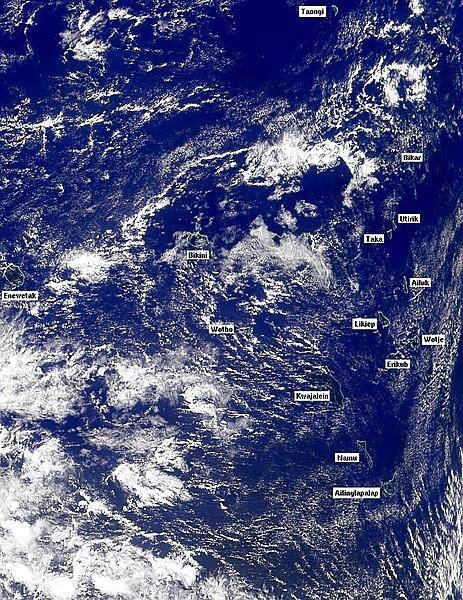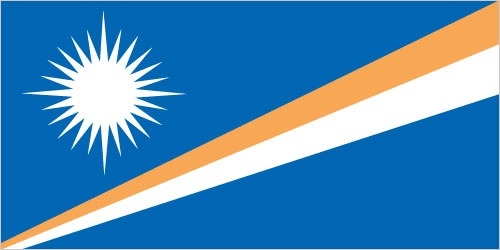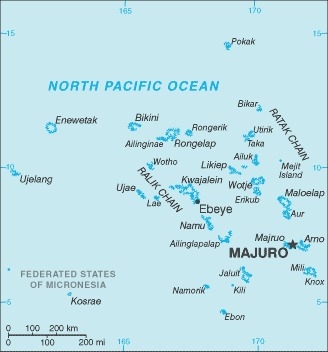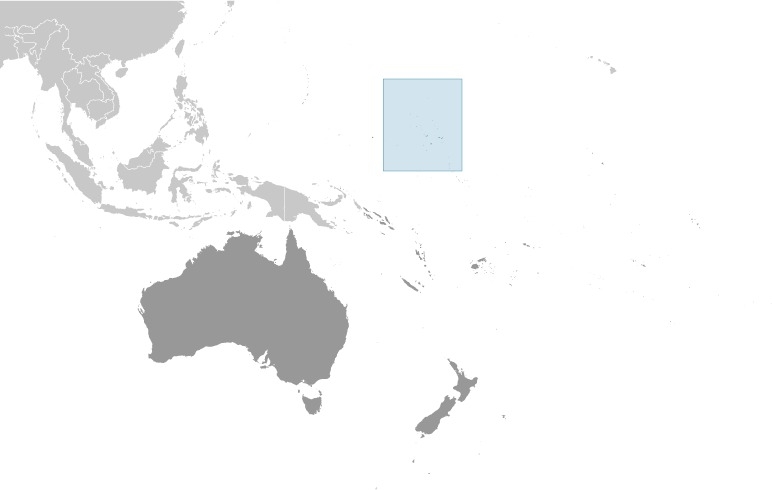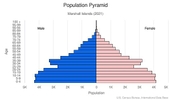Marshall Islands
Introduction
Background
Humans arrived in the Marshall Islands in the first millennium B.C. and gradually created permanent settlements on the various atolls. The early inhabitants were skilled navigators who frequently traveled between atolls using stick charts to map the islands. Society became organized under two paramount chiefs, one each for the Ratak (Sunrise) Chain and the Ralik (Sunset) Chain. The traditional hierarchy continued even after contact with Europeans in the early 1500s. Spain formally claimed the islands in 1592, but few other Europeans passed by the islands in the next two centuries. In 1788, British sea captain John MARSHALL undertook an exploratory voyage, and the islands were mapped in the early 1800s by Russian explorers. In the 1850s, US Protestant missionaries began arriving on the islands. Germany established a supply station on Jaluit Atoll and bought the islands from Spain in 1884, although paramount chiefs continued to rule.
Japan seized the Marshall Islands in 1914 and was granted a League of Nations Mandate to administer the islands in 1920. Japan built large military bases throughout the Marshall Islands, and during World War II, the US captured the bases on Kwajalein, Enewetak, and Majuro Atolls in Operations Flintlock and Catchpole. The Marshall Islands came under US administration as part of the Trust Territory of the Pacific Islands (TTPI) in 1947. Between 1946 and 1958, the US resettled populations from Bikini and Enewetak Atolls and conducted 67 nuclear tests; people from Ailinginae and Rongelap Atolls were also evacuated because of nuclear fallout, and all four atolls remain largely uninhabited. In 1979, the Marshall Islands drafted a constitution separate from the rest of the TTPI and declared independence under President Amata KABUA, a paramount chief. In 2000, Kessai NOTE became the first commoner elected president. In 2016, Hilda HEINE was the first woman elected president.
In 1982, the Marshall Islands signed a Compact of Free Association (COFA) with the US, which granted the Marshall Islands financial assistance and access to many US domestic programs in exchange for exclusive US military access and defense responsibilities; the COFA entered into force in 1986 and its funding was renewed in 2003. The Marshall Islands hosts the US Army Kwajalein Atoll Reagan Missile Test Site, a key installation in the US missile defense network. Kwajalein also hosts one of four dedicated ground antennas that assist in the operation of the Global Positioning System (GPS) navigation system (the others are at Cape Canaveral, Florida (US), on Ascension (Saint Helena, Ascension, and Tristan da Cunha), and at Diego Garcia (British Indian Ocean Territory)).
Visit the Definitions and Notes page to view a description of each topic.
Geography
Location
Oceania, consists of 29 atolls and five isolated islands in the North Pacific Ocean, about halfway between Hawaii and Australia; the atolls and islands are situated in two, almost-parallel island chains - the Ratak (Sunrise) group and the Ralik (Sunset) group; the total number of islands and islets is about 1,225; 22 of the atolls and four of the islands are uninhabited
Geographic coordinates
9 00 N, 168 00 E
Map references
Oceania
Area
total: 181 sq km
land: 181 sq km
water: 0 sq km
note: the archipelago includes 11,673 sq km of lagoon waters and encompasses the atolls of Bikini, Enewetak, Kwajalein, Majuro, Rongelap, and Utirik
Area - comparative
about the size of Washington, DC
Land boundaries
total: 0 km
Coastline
370.4 km
Maritime claims
territorial sea: 12 nm
contiguous zone: 24 nm
exclusive economic zone: 200 nm
Climate
tropical; hot and humid; wet season May to November; islands border typhoon belt
Terrain
low coral limestone and sand islands
Elevation
highest point: East-central Airik Island, Maloelap Atoll 14 m
lowest point: Pacific Ocean 0 m
mean elevation: 2 m
Natural resources
coconut products, marine products, deep seabed minerals
Land use
agricultural land: 50.7% (2018 est.)
arable land: 7.8% (2018 est.)
permanent crops: 31.2% (2018 est.)
permanent pasture: 11.7% (2018 est.)
forest: 49.3% (2018 est.)
other: 0% (2018 est.)
Irrigated land
0 sq km (2012)
Population distribution
most people live in urban clusters found on many of the country's islands; more than two-thirds of the population lives on the atolls of Majuro and Ebeye
Natural hazards
infrequent typhoons
Geography - note
the islands of Bikini and Enewetak are former US nuclear test sites; Kwajalein atoll, famous as a World War II battleground, surrounds the world's largest lagoon and is used as a US missile test range; the island city of Ebeye is the second largest settlement in the Marshall Islands, after the capital of Majuro, and one of the most densely populated locations in the Pacific
People and Society
Nationality
noun: Marshallese (singular and plural)
adjective: Marshallese
Ethnic groups
Marshallese 92.1%, mixed Marshallese 5.9%, other 2% (2006 est.)
Languages
Marshallese (official) 98.2%, other languages 1.8% (1999 est.)
major-language sample(s):
Bok eo an Lalin kin Melele ko Rejimwe ej jikin ebōk melele ko raurōk. (Marshallese)
The World Factbook, the indispensable source for basic information.
note: English (official), widely spoken as a second language
Religions
Protestant 80.5% (United Church of Christ 47%, Assembly of God 16.2%, Bukot Nan Jesus 5.4%, Full Gospel 3.3%, Reformed Congressional Church 3%, Salvation Army 1.9%, Seventh Day Adventist 1.4%, Meram in Jesus 1.2%, other Protestant 1.1%), Roman Catholic 8.5%, Church of Jesus Christ 7%, Jehovah's Witness 1.7%, other 1.2%, none 1.1% (2011 est.)
Age structure
0-14 years: 32.94% (male 13,090/female 12,575)
15-24 years: 19.09% (male 7,568/female 7,308)
25-54 years: 37.35% (male 14,834/female 14,270)
55-64 years: 5.92% (male 2,269/female 2,341)
65 years and over: 4.7% (male 1,805/female 1,857) (2020 est.)
Dependency ratios
total dependency ratio: NA
youth dependency ratio: NA
elderly dependency ratio: NA
potential support ratio: NA
Median age
total: 23.8 years
male: 23.6 years
female: 23.9 years (2020 est.)
Population distribution
most people live in urban clusters found on many of the country's islands; more than two-thirds of the population lives on the atolls of Majuro and Ebeye
Urbanization
urban population: 78.2% of total population (2021)
rate of urbanization: 0.61% annual rate of change (2020-25 est.)
Major urban areas - population
31,000 MAJURO (capital) (2018)
Sex ratio
at birth: 1.05 male(s)/female
0-14 years: 1.04 male(s)/female
15-24 years: 1.04 male(s)/female
25-54 years: 1.04 male(s)/female
55-64 years: 0.97 male(s)/female
65 years and over: 0.97 male(s)/female
total population: 1.03 male(s)/female (2020 est.)
Infant mortality rate
total: 22.2 deaths/1,000 live births
male: 25.83 deaths/1,000 live births
female: 18.4 deaths/1,000 live births (2021 est.)
Life expectancy at birth
total population: 74.38 years
male: 72.12 years
female: 76.76 years (2021 est.)
Drinking water source
improved: urban: 99.8% of population
rural: 99.7% of population
total: 99.8% of population
unimproved: urban: 0.2% of population
rural: 0.3% of population
total: 0.2% of population (2017 est.)
Current Health Expenditure
17.6% (2018)
Physicians density
0.42 physicians/1,000 population (2012)
Hospital bed density
2.7 beds/1,000 population
Sanitation facility access
improved: urban: 96.3% of population
rural: 65.4% of population
total: 89.1% of population
unimproved: urban: 15.5% of population
rural: 34.6% of population
total: 10.9% of population (2017 est.)
Major infectious diseases
degree of risk: high (2020)
food or waterborne diseases: bacterial diarrhea
vectorborne diseases: malaria
Literacy
definition: age 15 and over can read and write
total population: 98.3%
male: 98.3%
female: 98.2% (2011)
School life expectancy (primary to tertiary education)
total: 10 years
male: 10 years
female: 10 years (2019)
Unemployment, youth ages 15-24
total: 26%
male: 31%
female: 14.2% (2019 est.)
Environment
Environment - current issues
inadequate supplies of potable water; pollution of Majuro lagoon from household waste and discharges from fishing vessels; sea level rise
Environment - international agreements
party to: Biodiversity, Climate Change, Climate Change-Kyoto Protocol, Climate Change-Paris Agreement, Comprehensive Nuclear Test Ban, Desertification, Hazardous Wastes, Law of the Sea, Marine Dumping-London Protocol, Ozone Layer Protection, Ship Pollution, Wetlands, Whaling
signed, but not ratified: none of the selected agreements
Air pollutants
particulate matter emissions: 9.43 micrograms per cubic meter (2016 est.)
carbon dioxide emissions: 0.14 megatons (2016 est.)
methane emissions: 0.03 megatons (2020 est.)
Climate
tropical; hot and humid; wet season May to November; islands border typhoon belt
Land use
agricultural land: 50.7% (2018 est.)
arable land: 7.8% (2018 est.)
permanent crops: 31.2% (2018 est.)
permanent pasture: 11.7% (2018 est.)
forest: 49.3% (2018 est.)
other: 0% (2018 est.)
Urbanization
urban population: 78.2% of total population (2021)
rate of urbanization: 0.61% annual rate of change (2020-25 est.)
Revenue from forest resources
forest revenues: 0% of GDP (2018 est.)
country comparison to the world: 185Major infectious diseases
degree of risk: high (2020)
food or waterborne diseases: bacterial diarrhea
vectorborne diseases: malaria
Waste and recycling
municipal solid waste generated annually: 8,614 tons (2013 est.)
municipal solid waste recycled annually: 2,653 tons (2007 est.)
percent of municipal solid waste recycled: 30.8% (2007 est.)
Total renewable water resources
0 cubic meters (2017 est.)
Government
Country name
conventional long form: Republic of the Marshall Islands
conventional short form: Marshall Islands
local long form: Republic of the Marshall Islands
local short form: Marshall Islands
former: Trust Territory of the Pacific Islands, Marshall Islands District
abbreviation: RMI
etymology: named after British Captain John MARSHALL, who charted many of the islands in 1788
Government type
mixed presidential-parliamentary system in free association with the US
Capital
name: Majuro; note - the capital is an atoll of 64 islands; governmental buildings are housed on three fused islands on the eastern side of the atoll: Djarrit, Uliga, and Delap
geographic coordinates: 7 06 N, 171 23 E
time difference: UTC+12 (17 hours ahead of Washington, DC, during Standard Time)
etymology: Majuro means "two openings" or "two eyes" and refers to the two major northern passages through the atoll into the Majuro lagoon
Administrative divisions
24 municipalities; Ailinglaplap, Ailuk, Arno, Aur, Bikini & Kili, Ebon, Enewetak & Ujelang, Jabat, Jaluit, Kwajalein, Lae, Lib, Likiep, Majuro, Maloelap, Mejit, Mili, Namorik, Namu, Rongelap, Ujae, Utrik, Wotho, Wotje
Independence
21 October 1986 (from the US-administered UN trusteeship)
National holiday
Constitution Day, 1 May (1979)
Constitution
history: effective 1 May 1979
amendments: proposed by the National Parliament or by a constitutional convention; passage by Parliament requires at least two-thirds majority vote of the total membership in each of two readings and approval by a majority of votes in a referendum; amendments submitted by a constitutional convention require approval of at least two thirds of votes in a referendum; amended several times, last in 2018
Legal system
mixed legal system of US and English common law, customary law, and local statutes
International law organization participation
accepts compulsory ICJ jurisdiction with reservations; accepts ICCt jurisdiction
Citizenship
citizenship by birth: no
citizenship by descent only: at least one parent must be a citizen of the Marshall Islands
dual citizenship recognized: no
residency requirement for naturalization: 5 years
Suffrage
18 years of age; universal
Executive branch
chief of state: President David KABUA (since 13 January 2020); note - the president is both chief of state and head of government
head of government: President David KABUA (since 13 January 2020)
cabinet: Cabinet nominated by the president from among members of the Nitijela, appointed by Nitijela speaker
elections/appointments: president indirectly elected by the Nitijela from among its members for a 4-year term (no term limits); election last held on 6 January 2020 (next to be held in 2024)
election results: David KABUA elected president; Parliament vote - David KABUA 20, Hilda C. HEINE 12
Legislative branch
description: bicameral National Parliament consists of:
Council of Iroij, a 12-member group of tribal leaders advises the Presidential Cabinet and reviews legislation affecting customary law or any traditional practice); members appointed to serve 1-year terms
Nitijela (33 seats; members in 19 single- and 5 multi-seat constituencies directly elected by simple majority vote to serve 4-year terms); note - legislative power resides in the Nitijela
elections: last held on 18 November 2019 (next to be held by November 2023)
election results: percent of vote by party - NA; seats by party - independent 33
Judicial branch
highest courts: Supreme Court (consists of the chief justice and 2 associate justices)
judge selection and term of office: judges appointed by the Cabinet upon the recommendation of the Judicial Service Commission (consists of the chief justice of the High Court, the attorney general and a private citizen selected by the Cabinet) and upon approval of the Nitijela; the current chief justice, appointed in 2013, serves for 10 years; Marshallese citizens appointed as justices serve until retirement at age 72
subordinate courts: High Court; District Courts; Traditional Rights Court; Community Courts
Political parties and leaders
traditionally there have been no formally organized political parties; what has existed more closely resembles factions or interest groups because they do not have party headquarters, formal platforms, or party structures
International organization participation
ACP, ADB, AOSIS, FAO, G-77, IAEA, IBRD, ICAO, ICCt, IDA, IFAD, IFC, ILO, IMF, IMO, IMSO, Interpol, IOC, IOM, ITU, OPCW, PIF, Sparteca, SPC, UN, UNCTAD, UNESCO, WHO
Diplomatic representation in the US
chief of mission: Ambassador Gerald M. ZACKIOS (since 16 September 2016)
chancery: 2433 Massachusetts Avenue NW, Washington, DC 20008
telephone: [1] (202) 234-5414
FAX: [1] (202) 232-3236
email address and website:
info@rmiembassyus.org
https://www.rmiembassyus.org/
consulate(s) general: Honolulu, Springdale (AR)
Diplomatic representation from the US
chief of mission: Ambassador Roxanne CABRAL (since 6 February 2020)
embassy: Mejen Weto, Ocean Side, Majuro
mailing address: 4380 Majuro Place, Washington DC 20521-4380
telephone: [692] 247-4011
FAX: [692] 247-4012
email address and website:
MAJConsular@state.gov
https://mh.usembassy.gov/
Flag description
blue with two stripes radiating from the lower hoist-side corner - orange (top) and white; a white star with four large rays and 20 small rays appears on the hoist side above the two stripes; blue represents the Pacific Ocean, the orange stripe signifies the Ralik Chain or sunset and courage, while the white stripe signifies the Ratak Chain or sunrise and peace; the star symbolizes the cross of Christianity, each of the 24 rays designates one of the electoral districts in the country and the four larger rays highlight the principal cultural centers of Majuro, Jaluit, Wotje, and Ebeye; the rising diagonal band can also be interpreted as representing the equator, with the star showing the archipelago's position just to the north
National symbol(s)
a 24-rayed star; national colors: blue, white, orange
Economy
Economic overview
US assistance and lease payments for the use of Kwajalein Atoll as a US military base are the mainstay of this small island country. Agricultural production, primarily subsistence, is concentrated on small farms; the most important commercial crops are coconuts and breadfruit. Industry is limited to handicrafts, tuna processing, and copra. Tourism holds some potential. The islands and atolls have few natural resources, and imports exceed exports.
The Marshall Islands received roughly $1 billion in aid from the US during the period 1986-2001 under the original Compact of Free Association (Compact). In 2002 and 2003, the US and the Marshall Islands renegotiated the Compact's financial package for a 20-year period, 2004 to 2024. Under the amended Compact, the Marshall Islands will receive roughly $1.5 billion in direct US assistance. Under the amended Compact, the US and Marshall Islands are also jointly funding a Trust Fund for the people of the Marshall Islands that will provide an income stream beyond 2024, when direct Compact aid ends.
Real GDP (purchasing power parity)
$240 million note: data are in 2017 dollars (2019 est.)
$220 million note: data are in 2017 dollars (2018 est.)
$219 million (2017 est.)
note: data are in 2017 dollars
Real GDP growth rate
2.5% (2017 est.)
3.6% (2016 est.)
2% (2015 est.)
Real GDP per capita
$4,000 note: data are in 2017 dollars (2019 est.)
$3,800 note: data are in 2017 dollars (2018 est.)
$3,776 (2017 est.)
note: data are in 2017 dollars
GDP (official exchange rate)
$222 million (2017 est.)
GDP - composition, by sector of origin
agriculture: 4.4% (2013 est.)
industry: 9.9% (2013 est.)
services: 85.7% (2013 est.)
GDP - composition, by end use
government consumption: 50% (2016 est.)
investment in fixed capital: 17.8% (2016 est.)
investment in inventories: 0.2% (2016 est.)
exports of goods and services: 52.9% (2016 est.)
imports of goods and services: -102.3% (2016 est.)
Agricultural products
coconuts
Industries
copra, tuna processing, tourism, craft items (from seashells, wood, and pearls)
Labor force - by occupation
agriculture: 11%
industry: 16.3%
services: 72.7% (2011 est.)
Household income or consumption by percentage share
lowest 10%: NA
highest 10%: NA
Budget
revenues: 116.7 million (2013 est.)
expenditures: 113.9 million (2013 est.)
Fiscal year
1 October - 30 September
Current account balance
-$1 million (2017 est.)
$15 million (2016 est.)
Exports
$130 million note: data are in current year dollars (2018 est.)
country comparison to the world: 208Exports - partners
Poland 28%, Denmark 19%, South Korea 13%, Indonesia 10%, Cyprus 6% (2019)
Exports - commodities
ships, fish, recreational boats, broadcasting equipment, coal tar oil (2019)
Imports
$170 million note: data are in current year dollars (2018 est.)
$103.8 million (2016 est.)
Imports - partners
South Korea 39%, China 27%, Japan 15% (2019)
Imports - commodities
ships, refined petroleum, centrifuges, recreational boats, boat propellers (2019)
Debt - external
$97.96 million (2013 est.)
$87 million (2008 est.)
Exchange rates
the US dollar is used
Unemployment, youth ages 15-24
total: 26%
male: 31%
female: 14.2% (2019 est.)
Energy
Electricity access
electrification - total population: 96.3% (2018)
electrification - urban areas: 95.7% (2018)
electrification - rural areas: 98.4% (2018)
Electricity - installed generating capacity
52,000 kW (2016 est.)
country comparison to the world: 189Electricity - from fossil fuels
81% of total installed capacity (2016 est.)
country comparison to the world: 81Electricity - from nuclear fuels
0% of total installed capacity (2017 est.)
country comparison to the world: 140Electricity - from hydroelectric plants
19% of total installed capacity (2017 est.)
country comparison to the world: 90Electricity - from other renewable sources
0% of total installed capacity (2017 est.)
country comparison to the world: 200Refined petroleum products - consumption
2,000 bbl/day (2016 est.)
country comparison to the world: 195Communications
Telephones - fixed lines
total subscriptions: 2,361 (2018)
subscriptions per 100 inhabitants: 4.13 (2018 est.)
Telephones - mobile cellular
total subscriptions: 16,000 (2018)
subscriptions per 100 inhabitants: 27.56 (2019 est.)
Telecommunication systems
general assessment: some telecom infrastructure improvements made in recent years; modern services include fiber optic cable service, cellular, Internet, international calling, caller ID, and leased data circuits; the US Government, World Bank, UN and International Telecommunication Union (ITU), have aided in improvements and monetary aid to the islands telecom; mobile penetrations is around 30%; radio communication is especially vital to remote islands (2018)
domestic: Majuro Atoll and Ebeye and Kwajalein islands have regular, seven-digit, direct-dial telephones; other islands interconnected by high frequency radiotelephone (used mostly for government purposes) and mini-satellite telephones; fixed-line 4 per 100 persons and mobile-cellular is 28 per 100 persons (2019)
international: country code - 692; satellite earth stations - 2 Intelsat (Pacific Ocean); US Government satellite communications system on Kwajalein
note: the COVID-19 pandemic continues to have a significant impact on production and supply chains globally; since 2020, some aspects of the telecom sector have experienced downturn, particularly in mobile device production; many network operators delayed upgrades to infrastructure; progress towards 5G implementation was postponed or slowed in some countries; consumer spending on telecom services and devices was affected by large-scale job losses and the consequent restriction on disposable incomes; the crucial nature of telecom services as a tool for work and school from home became evident, and received some support from governments
Broadcast media
no TV broadcast station; a cable network is available on Majuro with programming via videotape replay and satellite relays; 4 radio broadcast stations; American Armed Forces Radio and Television Service (AFRTS) provides satellite radio and television service to Kwajalein Atoll (2019)
Internet users
total: 23,000 (2021 est.)
percent of population: 38.7% (2019 est.)
Broadband - fixed subscriptions
total: 1,000 (2017 est.)
subscriptions per 100 inhabitants: 1.72 (2019 est.)
Communications - note
Kwajalein hosts one of four dedicated ground antennas that assist in the operation of the Global Positioning System (GPS) navigation system (the others are at Cape Canaveral, Florida (US), on Ascension (Saint Helena, Ascension, and Tristan da Cunha), and at Diego Garcia (British Indian Ocean Territory))
Transportation
National air transport system
number of registered air carriers: 1 (2020)
inventory of registered aircraft operated by air carriers: 3
annual passenger traffic on registered air carriers: 24,313 (2018)
annual freight traffic on registered air carriers: 130,000 mt-km (2018)
Airports - with paved runways
total: 4
1,524 to 2,437 m: 3
914 to 1,523 m: 1 (2017)
Airports - with unpaved runways
total: 11
914 to 1,523 m: 10
under 914 m: 1 (2013)
Roadways
total: 2,028 km (2007)
paved: 75 km (2007)
unpaved: 1,953 km
Merchant marine
total: 3,817
by type: bulk carrier 1,733, container ship 248, general cargo 66, oil tanker 970, other 800 (2021)
Ports and terminals
major seaport(s): Enitwetak Island, Kwajalein, Majuro
Military and Security
Military and security forces
no regular military forces; the national police (Marshall Islands Police Department, MIPD), local police forces, and the Sea Patrol (maritime police) maintain internal security; the MIPD and Sea Patrol report to the Ministry of Justice; local police report to their respective local government councils
Military - note
defense is the responsibility of the US
Transnational Issues
Disputes - international
claims US territory of Wake Island
Trafficking in persons
current situation: The Marshall Islands are a destination country for women from East Asia subjected to sex trafficking; foreign women are reportedly forced into prostitution in bars frequented by crew members of fishing vessels; some Chinese women are recruited to the Marshall Islands with promises of legitimate work and are subsequently forced into prostitution; wealthy or powerful families use traditional cultural practices to exploit impoverished Marshallese from outer islands as indentured laborers on their property; Marshallese children are transported to the United States and subjected to sexual abuse
tier rating: Tier 2 Watch List — the Marshall Islands does not fully comply with the minimum standards for the elimination of trafficking but is making significant efforts to do so; efforts include its first trafficking prosecution since 2011 and opening an investigation into an immigration official for alleged trafficking complicity; however, no efforts were made to identify trafficking victims and no assistance was provided to victims; the government has not convicted any traffickers since 2011 (2020)
